Exposición Tesoros de arte asiático // Treasures of Asian Art Exhibition
Click here to read this post in English

Hola querido hiver.
Las colecciones que compartiré en esta publicación no me pertenecen, ya me gustaría que así fuera. Pero precisamente por eso son más valiosas si cabe, pues no podemos disfrutarlas si no se exponen en algún lugar. Normalmente se custodian en el Museo de Zaragoza, que ahora está cerrado por obras de reformas, y por ese motivo el Gobierno de Aragón y el Ayuntamiento de Zaragoza colaboran para acercarnos a las colecciones que forman la Sección de Arte Asiático del Museo de Zaragoza.
Ha sido difícil seleccionar las piezas para mostrarte aquí, pues he tenido que bucear entre más de 100 fotografías, espero que te gusten.
Para que puedas seguir el post con más facilidad separaré las colecciones mediante títulos e incluiré un poco de información sobre cada una obtenida de los paneles informativos y del folleto oficial de la exposición, al que puedes acceder mediante este enlace. Tras eso irán las fotografías de las piezas.
Colección Torralba: Religión en Asia
Los fondos de la colección de Federico Torralba se diferencian en tres grupos: arte relacionado con el budismo y otras religiones predominantes en la región asiática, arte de China y arte de Japón. Por ese motivo irán en apartados como si se tratasen de colecciones independientes, ya que así se mostraban en la exposición.
En este apartado podemos encontrar piezas de Tailandia, Birmania, Indonesia, Tíbet, Nepal, India, Corea, Turquía e Irán, destacando sobre todo las figuras de Buda en diversas posiciones o partes.
Colección Torralba: China
Aquí no podía faltar la famosa porcelana china, las sedas bordadas, los muebles lacados o los juegos de té. Pero lo que más me gustó fueron las diminutas botellas de rapé que estaban decoradas con una precisión milimétrica.
Colección Torralba: Japón
Comenzamos por la cerámica, continuamos por biombos dorados exquisitamente pintados y desembocamos en caligrafías y pinturas. Los libros xilográficos con figuras femeninas son mis preferidos.
Colección Torralba: Laca urushi
Dentro del arte japonés la exposición dedica un apartado exclusivo a este arte:
El arte de la laca urushi es una de las manifestaciones artísticas en las que la cultura japonesa ha alcanzado mayores cotas de calidad, perfección técnica y refinamiento. Consiste en el revestimiento de objetos, generalmente realizados en madera, con laca urushi. Una vez lacados, las piezas reciben delicadas y complejas decoraciones a base de makie, técnica ornamental por excelencia de este arte nipón, y que consiste en la realización de diseños decorativos mediante la aplicación de partículas de oro y plata. También encontramos otro tipo de decoraciones a base de incrustaciones de nácar, piedras, metales o marfil.
Colección Gobierno de Aragón
Con la creación de la Sección de Arte Asiático del Museo de Zaragoza el gobierno de la región incrementó su interés por adquirir obras para sus fondos. La más reciente ha sido una armadura samurái que se completa con casco, máscara, armadura completa, abanico, bastón de mando, estandartes y, algo inusual, sus bolsas originales de tela para proteger y almacenar las piezas. Está fechada alrededor del año 1700 y destaca por su belleza, algo que sorprende en este tipo de objetos y da muestra de que perteneció a alguien de gran relevancia.
Fundación Torralba-Fortún
Debido al pacto sucesorio firmado entre Federico Torralba Soriano y el Gobierno de Aragón -mediante el cual legaba su colección asiática y su biblioteca especializada- la Comunidad Autónoma de Aragón asumió el compromiso de crear una fundación destinada a exponer y difundir sus obras, así como a fomentar el estudio del arte asiático. Así nació en 2002 la Fundación Torralba-Fortún, a cuyos objetivos se sumaba la promoción de la obra del pintor Antonio Fortún (1945-1999), quien acompañó a Torralba durante gran parte de su vida y fue figura clave en el crecimiento y cuidado de la colección oriental hasta su prematura muerte.
La fundación cuenta con una sólida trayectoria de publicaciones, organización de exposiciones, congresos y conferencias, concesión de becas y adquisición de nuevas piezas asiáticas. A través de estas iniciativas, busca fomentar el entendimiento y el acercamiento entre pueblos y culturas diversas.
Colección Familia Kotoge
Tanzan Kotoge fue un afamado artista que promovió los valores de la cerámica tradicional japonesa. Visitó varias veces Aragón, e impartió varios cursos en el Taller Escuela Cerámica de Muel. Al conocer el Museo de Zaragoza quiso donar y depositar en él parte de su obra. Su legado está continuado por su hijo Kentaro, que mantiene la firma de su padre.
Colección Pasamar-Onila
Sus estampas nos permiten realizar un recorrido exhaustivo por la historia del arte xilográfico japonés desde el siglo XVII hasta prácticamente nuestros días.
Presenta una importante nómina de artistas mujeres japonesas, entre las que encontramos autoras como Katsushika Õi, Seisõjo, Kawanabe Gyösui, Tai Köun, Ikeda Shöen, Shima Seien, Chigusa Kitani, Takenaka Fu, Uemura Shõen o lida Shiko, cuyas obras pueden disfrutarse en esta sala. Las estampas de autoría femenina no son habituales.
La presencia de estas artistas convierte al Museo de Zaragoza, gracias a la generosa labor de Víctor Pasamar Gracia, en una de las instituciones europeas más relevantes en este sentido.
Colección Miguel Ángel Gutiérrez Pascual
Se centra en las representaciones teatrales japonesas, kabuki, noh y kyogen, así como historias y leyendas míticas de Japón, con especial atención al mundo de los yokai, criaturas sobrenaturales del folklore japonés.
Esta colección presenta obras pertenecientes a las escuelas ukiyo-e y shin-hanga.
A día de hoy, se compone de unas 650 estampas firmadas por autores de primera línea.
Una sorpresa final
Antes de la salida encontramos un espacio en el que se nos explica la técnica de la xilografía y podemos llevarnos un recuerdo realizado por nosotros mismos. Me gustó este detalle, que sin duda los niños apreciarán pero que los adultos tampoco desdeñamos.
Hasta la próxima publicación. Mientras tanto, ¡cuídate!

Herramientas: Cámara iPhone 13 Pro, editor de fotos Mac.
Mis publicaciones en Worldmappin pinchando aquí
Si te gusta lo que publico, únete a mi Fanbase pinchando aquí

©️Copyright 2025 Paloma Peña Pérez. Todos los derechos reservados.


Hi, dear hiver.
The collections I will share in this post do not belong to me, although I wish they did. But that is precisely why they are even more valuable, as we cannot enjoy them unless they are exhibited somewhere. They are normally kept at the Museum of Zaragoza, which is currently closed for renovation, and for this reason the Government of Aragon and Zaragoza City Council are collaborating to bring us closer to the collections that make up the Asian Art Section of the Museum of Zaragoza.
It has been difficult to select the pieces to show you here, as I have had to dive into more than 100 photographs, but I hope you like them.
To make it easier for you to follow the post, I will separate the collections by title and include a little information about each one obtained from the information panels and the official exhibition brochure, which you can access via this link. After that, I will show you the photographs of the pieces.
Torralba Collection: Religion in Asia
The Federico Torralba collection is divided into three groups: art related to Buddhism and other predominant religions in the Asian region, Chinese art, and Japanese art. For this reason, they will be presented in separate sections as if they were independent collections, as this is how they were displayed in the exhibition.
In this section, we can find pieces from Thailand, Burma, Indonesia, Tibet, Nepal, India, Korea, Turkey, and Iran, with the Buddha figures in various positions or parts standing out above all.
Torralba Collection: China
Of course, the famous Chinese porcelain, embroidered silks, lacquered furniture and tea sets were all here. But what I liked best were the tiny snuff bottles, decorated with pinpoint precision.
Torralba Collection: Japan
We begin with ceramics, continue with exquisitely painted golden screens, and end with calligraphy and paintings. The woodblock books featuring female figures are my favourites.
Torralba Collection: Urushi lacquer
Within Japanese art, the exhibition dedicates an exclusive section to this art form:
The art of urushi lacquer is one of the artistic expressions in which Japanese culture has achieved the highest levels of quality, technical perfection and refinement. It consists of coating objects, usually made of wood, with urushi lacquer. Once lacquered, the pieces are given delicate and complex decorations using makie, the ornamental technique par excellence of this Japanese art, which consists of creating decorative designs by applying particles of gold and silver. We also find other types of decorations based on inlays of mother-of-pearl, stones, metals or ivory.
Government of Aragon Collection
With the creation of the Asian Art Section of the Museum of Zaragoza, the regional government increased its interest in acquiring works for its collections. The most recent acquisition is a samurai armour set that includes a helmet, mask, full armour, fan, staff of office, banners and, unusually, the original cloth bags used to protect and store the pieces. It dates from around 1700 and is notable for its beauty, which is surprising in this type of object and indicates that it belonged to someone of great importance.
Torralba-Fortún Foundation
Due to the succession agreement signed between Federico Torralba Soriano and the Government of Aragon—through which he bequeathed his Asian collection and specialised library—the Autonomous Community of Aragon undertook to create a foundation dedicated to exhibiting and disseminating his works, as well as promoting the study of Asian art. Thus, in 2002, the Torralba-Fortún Foundation was born, whose objectives included promoting the work of the painter Antonio Fortún (1945-1999), who accompanied Torralba for much of his life and was a key figure in the growth and care of the oriental collection until his untimely death.
The foundation has a solid track record of publications, organising exhibitions, congresses and conferences, awarding scholarships and acquiring new Asian pieces. Through these initiatives, it seeks to promote understanding and rapprochement between diverse peoples and cultures.
Kotoge Family Collection
Tanzan Kotoge was a renowned artist who promoted the values of traditional Japanese ceramics. He visited Aragon several times and taught various courses at the Muel Ceramics Workshop School. Upon discovering the Museum of Zaragoza, he decided to donate and deposit part of his work there. His legacy is continued by his son Kentaro, who maintains his father's signature style.
Pasamar-Onila Collection
These prints allow us to take an exhaustive journey through the history of Japanese woodblock art from the 17th century to the present day.
It features an impressive list of Japanese female artists, including Katsushika Õi, Seisõjo, Kawanabe Gyösui, Tai Köun, Ikeda Shöen, Shima Seien, Chigusa Kitani, Takenaka Fu, Uemura Shõen and Lida Shiko, whose works can be enjoyed in this room. Prints by female artists are not common.
Thanks to the generous work of Víctor Pasamar Gracia, the presence of these artists makes the Museum of Zaragoza one of the most important European institutions in this regard.
Miguel Ángel Gutiérrez Pascual Collection
It focuses on Japanese theatrical performances, kabuki, noh and kyogen, as well as mythical stories and legends from Japan, with special attention to the world of yokai, supernatural creatures from Japanese folklore.
This collection features works belonging to the ukiyo-e and shin-hanga schools.
Today, it consists of some 650 prints signed by leading artists.
A final surprise
Before leaving, we find a space where the technique of woodcut printing is explained to us and we can take home a souvenir made by ourselves. I liked this detail, which children will undoubtedly appreciate, but adults will not disdain either.
Until the next post. In the meantime, take care!

Tools: iPhone 13 Pro camera, Mac photo editor.
Translated with DeepL
My publications in Worldmappin by clicking here
If you like my content, join my Fanbase clicking here

©️Copyright 2025 Paloma Peña Pérez. All rights reserved.











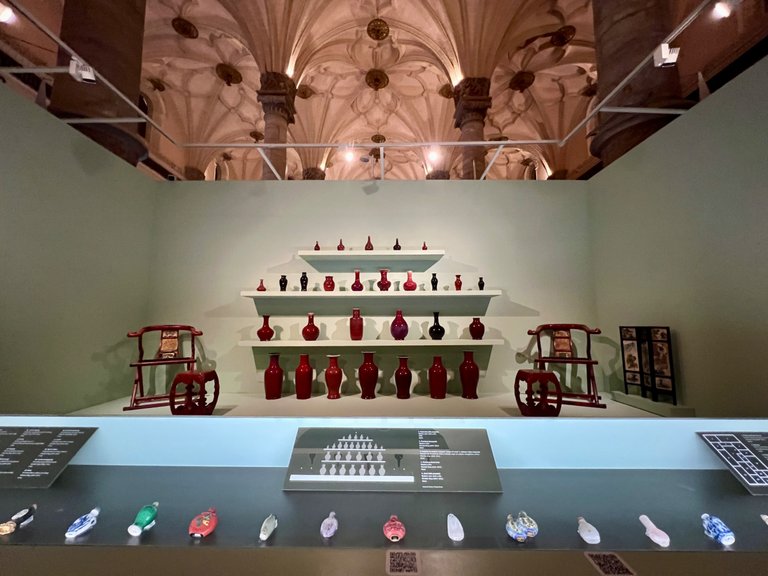

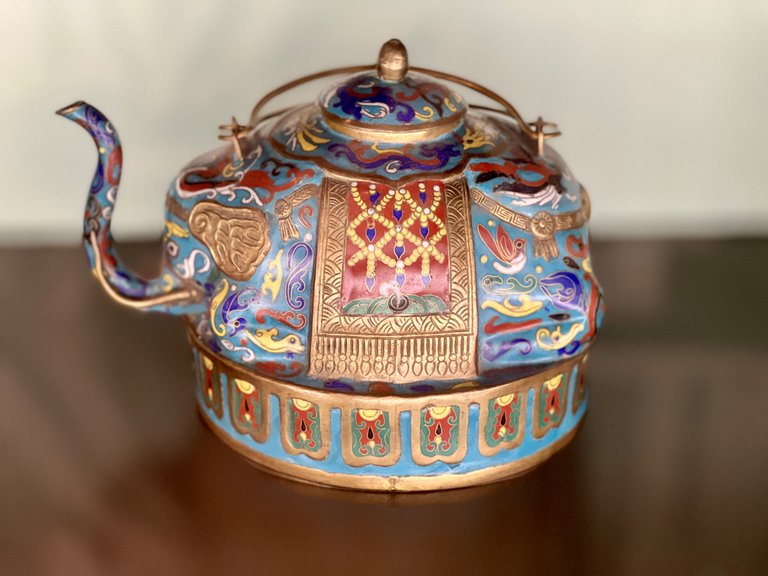


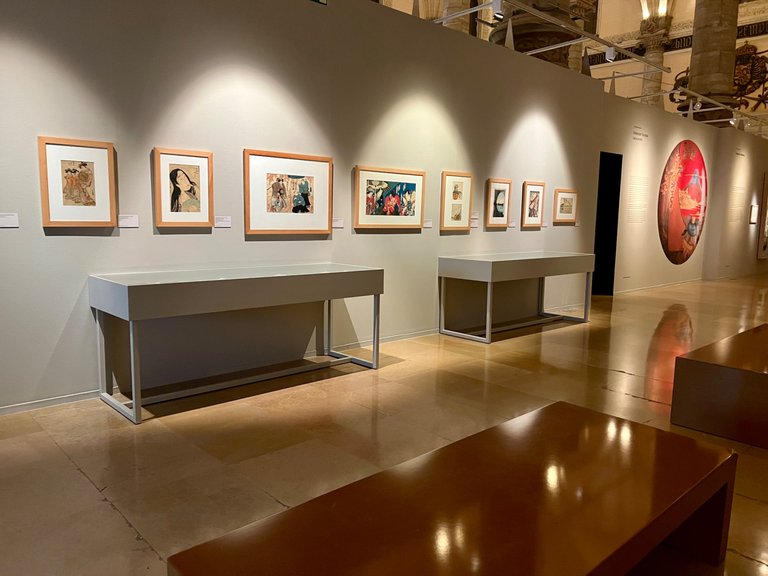



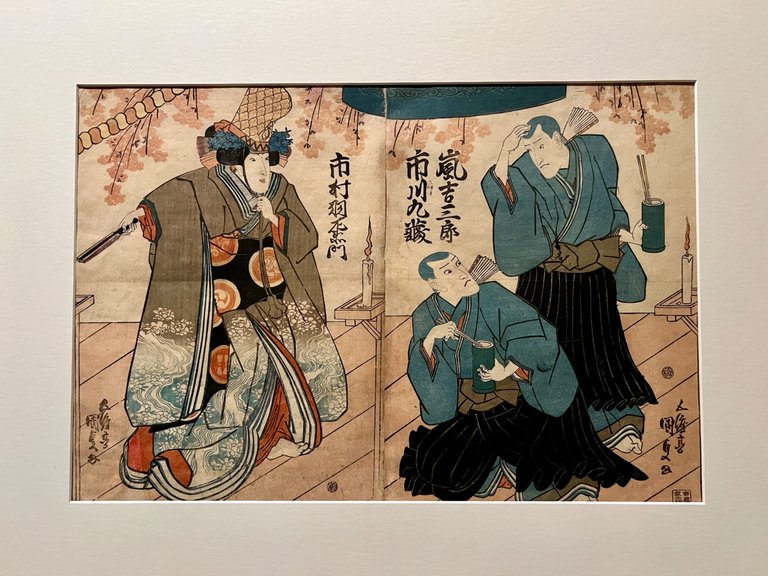




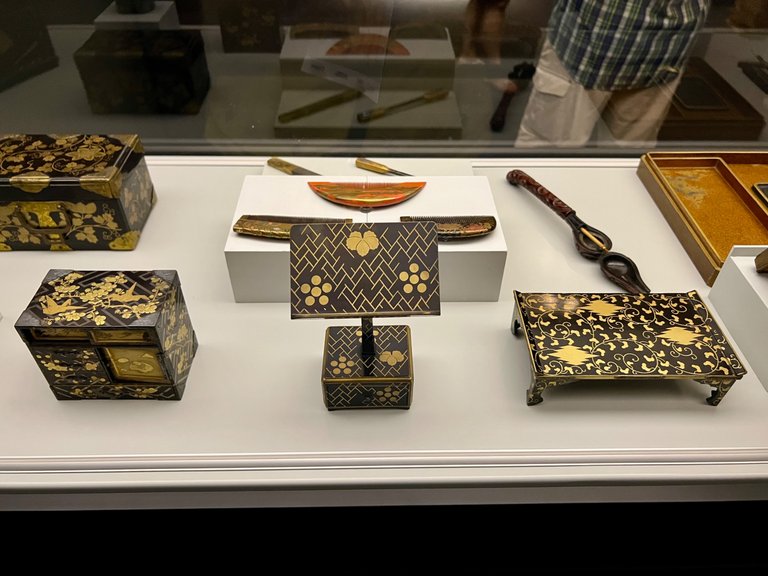


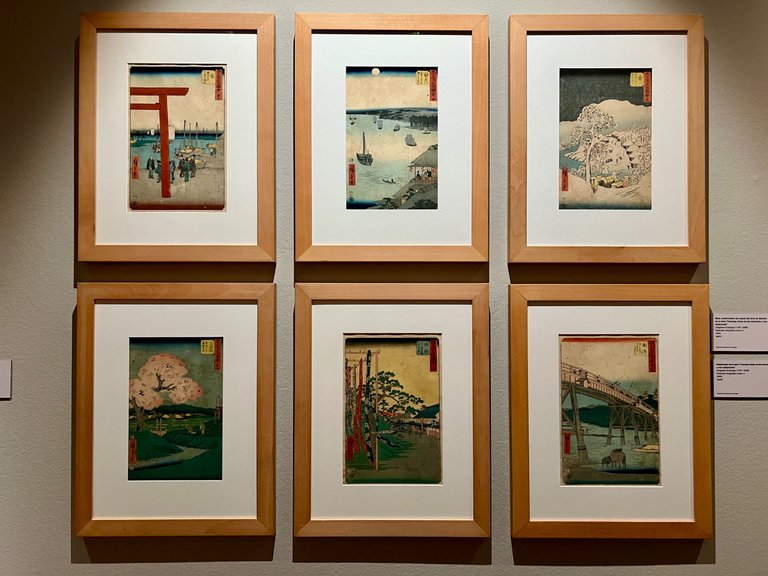

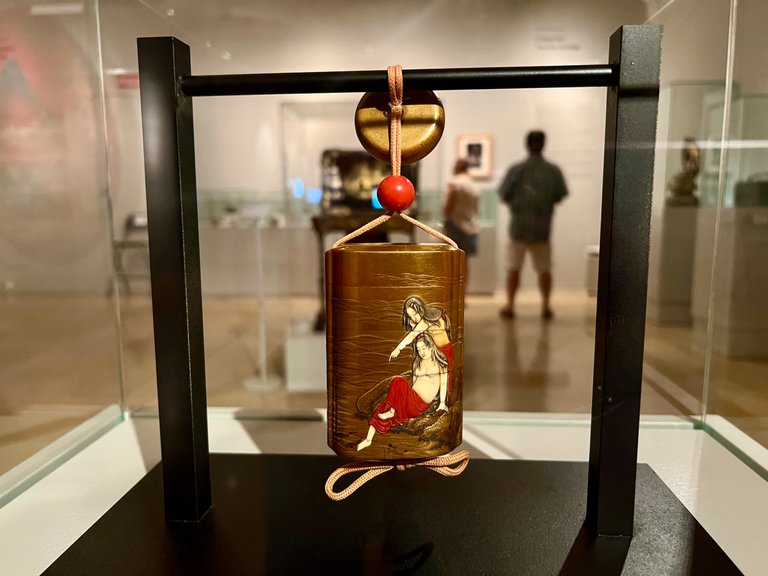















My eyes filled with joy and colours seeing the whole collection, with its beautiful details. I can relate to the difficulty of choosing the photos for a post among 100 or so heheh, I usually do the same if I see/visit such a great exhibition/collection and then can't reduce and choose 🤦♀. All your photos and the whole presentation of the collection is top-notch. Thank you for bringing this treasure to the Hive Collectors community, en realidad, es un tesoro tu publicación, no solo lo que vemos allí en la Lonja (de hecho, me acuerdo de ese sitio, porque lo visitamos juntos cuando vinimos por la primera vez a Zaragoza, había otra exposición - de fotografías). I am glad to see Buddha there, and a beautiful hand fan!!! But after seeing this teapot-elephant, I have no choice but to choose this as my favourite item from the whole exposition 😍:
Yes, discarding photos is often painful. When I really like them, I save them as reserves, and from time to time I manage to group them together to give them their chance to shine.
La Lonja always has interesting exhibitions, and the best thing is that they are free so that we can all enjoy art. El “elefantetera” es una preciosidad, ¡buena elección!
Jajaja, elefantetera - este nombre es perfecto! 😁
!HUG
!BBH
Thank you so much for the support! 💙
This Asian art is impressive, well preserved in that museum 😍 What I like about museums is that we can see with our own eyes the art and relics from many years ago, and it makes you wonder, "How did they do these things?" Many artists only used natural resources, without much technology, which makes them even more impressive ❤️
Back to the topic haha I've always loved Asian art, especially Eastern art. I find its culture and traditions so interesting and relevant, and the way they take it so seriously is amazing 😍 Beautiful!
I understand you well. I also wonder how they were able to create such delicate works without the tools and knowledge we have today. That makes them even more valuable!
This was my first time seeing Asian art in person. I had seen a few pieces here and there, but never so many objects gathered in one place. I left enchanted and eager to see more. From now on, I won't miss any opportunity that comes my way.
Buenos días, querida amiga @palomap3
Qué lugar tan hermoso has visitado, lleno de encanto para ver, me gusta que hayas ordenado las fotografías
De la colección de Torralba me gusta el juego de té de Asia, de la colección china me gusta el abanico y la pava tipo elefante, de la colección de Japón me gustaron los biombos
En realidad me ha gustado toda la colección que seleccionaste para mostrarnos, no habrá sido fácil agruparlos
Aprecio que te tomaras el tiempo para compartir las cosas bellas de esta exposición, hermoso obsequio
Que tengas un excelente día
Good morning, dear friend @palomap3
What a beautiful place you visited, full of charm. I love that you organized the photographs.
From the Torralba collection, I like the Asian tea set. From the Chinese collection, I like the fan and elephant-shaped kettle. From the Japanese collection, I liked the screens.
I really liked the entire collection you selected to show us. It couldn't have been easy to group them together.
I appreciate you taking the time to share the beautiful things in this exhibition. A lovely gift.
Have a great day.
Agruparlos ha sido sencillo porque el espacio estaba bien organizado, el problema ha sido descartar piezas que incluir aquí para que el post no se hiciera eterno. 🤭
Fue un placer recorrer la exposición, este tipo de arte me gusta mucho, es tan diferente a lo que acostumbramos a ver que despierta el interés.
Me alegro de que te haya gustado, gracias por la visita, el apoyo y el bonito comentario. 🤗
Buenos días @palomap3, qué maravilla de colección. No se ni por donde comenzar ni por donde acabar con el comentrario. Aunque si puedo mencionar de entre todas las colecciones que nos muestras la que más he disfrutado: la Colección Pasamar-Onila. El estilo de las obras de eta colección lo he usado en alguna de mis publicaciones usando IA para crear las imágenes, me encanta.
Pero es que todas las obras son una maravilla de buen gusto y elegancia. Sólo te me queda darte las gracias por compartir estas maravillas que aunque se encuentran expuestas en Zaragoza ya se encuentran en HIve. Gracias.
Un abrazo muy grande. 🤗
Good morning @palomap3, what a wonderful collection. I don't even know where to begin or end my comments. Although I can mention the collection I enjoyed the most out of all the ones you've shown us: the Pasamar-Onila Collection. I've used the style of the works in this collection in some of my publications, using AI to create the images. I love it.
But all the works are marvels of good taste and elegance. All that's left is to thank you for sharing these wonders, which, although they are on display in Zaragoza, are now on HIve. Thank you.
A big Hug. 🤗
Sabía que esta colección de colecciones te iba a gustar. Es un arte tan diferente al de nuestra cultura, delicado y detallista. La disfruté mucho, si te animas tienes tiempo hasta las próximas fiestas del Pilar. 😜
Si puedo te visito... y a la exposicón... también.
Un abrazo nuy grande. Graciaaaaaaaaaaaaaas!!
If I can, I'll visit you... and the exhibition... too.
A big hug. Thank you so much!!
View more
This post has been manually curated by @bhattg from Indiaunited community. Join us on our Discord Server.
Do you know that you can earn a passive income by delegating to @indiaunited. We share more than 100 % of the curation rewards with the delegators in the form of IUC tokens. HP delegators and IUC token holders also get upto 20% additional vote weight.
Here are some handy links for delegations: 100HP, 250HP, 500HP, 1000HP.
100% of the rewards from this comment goes to the curator for their manual curation efforts. Please encourage the curator @bhattg by upvoting this comment and support the community by voting the posts made by @indiaunited.
I was surprised to see so many Japanese works!
I also liked the woodblock print you mentioned. After looking it up, it seems the artist of this print is also a woman. Sadly, she passed away in 2022😭
Most of the works were old, but yes, there were some more modern ones too. I liked everything, but if I had to choose just one part, I would choose the Urushi lacquerware section. They are so beautiful.
You can check out this post and your own profile on the map. Be part of the Worldmappin Community and join our Discord Channel to get in touch with other travelers, ask questions or just be updated on our latest features.
Thank you for the pin! 📍
Hey @palomap3 you are welcome.
Thanks for using @worldmappin 😘
Hiya, @lauramica here, just swinging by to let you know that this post made it into our Honorable Mentions in Travel Digest #2679.
Your post has been manually curated by the @worldmappin team. If you like what we're doing, please drop by to check out all the rest of today's great posts and consider supporting other authors like yourself and us so we can keep the project going!
Become part of our travel community:
Thank you so much! 😊
You are very welcome @palomap3! it was well deserved. ☀️
We are already looking forward to reading more about your adventures!
What a beautiful place to visit. The artists all did a great job. I love the entire collection, it's wonderful. Thanks for sharing this beautiful art.
Yes, I’m glad to know that you like them too.
This is truly amazing...
The way the entire artists brought all this beautiful artwork to life is top notch.
Their dedication, service, and sacrifice are deeply appreciated.
And ma’am, thank you so much for sharing the history I truly enjoyed the stories, especially with the pictures of their works. It made everything even more engaging and fun to read
I'm glad you liked the artwork and stories. Since I've been able to share these experiences here on Hive, I enjoy them much more. 😃
solo me falta la espada y estamos listos jjaja, saludos carino lindo post

Pues sí, solo falta la espada. Es una pena que empleasen para guerrear una indumentaria tan costosa de elaborar y tan bonita. ¡Un abrazote! 🤗
Para ellos morir era el acto mas puro y bueno que mejor morir que como smoking tal como hoy jajaja
View more